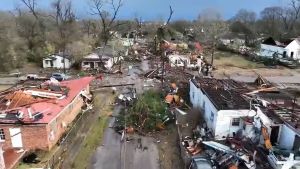“I’ve never seen anything like it.”
I can’t tell you how many times we heard that over and over again. We can and do see tornadoes at any time of the year, but not the kind of tornado outbreak that we saw earlier this year. A line of strong thunderstorms moved into north and central Georgia during the afternoon through the evening of Thursday, January 12th and spawned numerous tornadoes, including several that were long track and significant.
Ahead of this line, a few supercells also spawned tornadoes in portions of central and eastern Georgia. As of this writing, survey information is still being compiled and will be released in coming days. Thus, the final tornado count is still being determined. The total number of tornadoes stands at seven, with more to be added as the survey continues by the National Weather Service.

Damage from one of the January tornadoes.
As the system roared across Alabama, a massive supercell spawned an EF 3 tornado with a path of nearly 77 miles. It was an eighth of a mile wide and began at 12:40 p.m. Seven people lost their lives, mostly in mobile homes that could not withstand the 150 mph winds, as you can see in this photo.
I saw the set up in the computer models that Monday. Over us at about a mile up we were experiencing winds of about 65-75 mph. Higher into the atmosphere winds were increasing with speed and changing directions. A lot of wind shear was present. In addition to the windshear a weather system was coming in during the maximum heating of the day where temperatures were climbing into the upper 60s and low 70s, adding a lot of fuel to the storms. It looked like a March set up – not typical January weather.
The weather system came in from the West Coast, an atmospheric river that was pounding parts of California. It maintained its strength as it moved across the country, dropping heavy snows across the Rockies and horrific storms across the Southeast United States.
Another major factor contributing to this unprecedented outbreak were the unseasonably warm temperatures. NASA says 2022 was the 5th-warmest year on record with Earth’s average surface temperature in 2022 tied with 2015 according to the agency’s analysis. And the past nine years have been the warmest years since modern record-keeping began in 1880. Plus, in 2022, NASA scientists, as well as international scientists, determined that carbon dioxide emissions were the highest on record. Europe has seen incredible heat this winter as well. But it’s been the West Coast of the United States taking direct hits from massive atmospheric rivers of rain.
As we head into February I see signs of colder temperatures. Will we see snow? It’s anyone’s guess with this wild weather pattern. My best advice: Stay tuned and be ready for anything!
Photo: courtesy WBMA TV Birmingham




